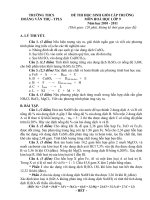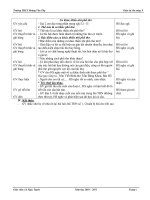trường thcs hoàng xuân hãn
Bạn đang xem bản rút gọn của tài liệu. Xem và tải ngay bản đầy đủ của tài liệu tại đây (88.17 KB, 11 trang )
<span class='text_page_counter'>(1)</span><div class='page_container' data-page=1>
World Youth Mathematics Intercity Competition
Team Contest
English Version
Instructions:
Do not turn to the first page until you are told to do so.
Remember to write down your team name in the space
indicated on the first page.
There are 10 problems in the Team Contest, arranged in
increasing order of difficulty. Each question is printed on a
separate sheet of paper. The four team members are allowed
10 minutes to discuss and distribute the first 8 problems
among themselves. Each student must solve at least one
problem by themselves. Each will then have 35 minutes to
write the solutions of their allotted problem independently with
no further discussion or exchange of problems. The four team
members are allowed 15 minutes to solve the last 2 problems
together. Each problem is worth 40 points and complete
solutions of problem 1, 2, 6, 7, 8, 9 and 10 are required for full
credits. Partial credits may be awarded.
No calculator or calculating device or electronic devices are
allowed.
Answer in pencil or in blue or black ball point pen.
Problems that required numerical answer must be filled in by
Arabic numeral only.
All materials will be collected at the end of the competition.
2
2
0
0
0
0
9
9
D
D
u
u
r
r
b
b
a
a
n
n
I
I
n
n
v
v
i
i
t
t
a
a
t
t
i
i
o
o
n
n
a
a
l
l
W
W
o
o
r
r
l
l
d
d
Y
Y
o
o
u
u
t
t
h
h
M
</div>
<span class='text_page_counter'>(2)</span><div class='page_container' data-page=2>
Team Contest
Time limit: 60 minutes 8
th<i> July 2009 Durban, South Africa </i>
<b>Team: </b> <b>Score: </b>
1. The cards 1 to 15 are arranged in a deck, not in numerical order. The top card is
placed on the table and the next card is transferred to the bottom of the deck.
Now the new top card is placed on top of the card on the table and the next card
is transferred to the bottom of the remaining deck. This process is repeated until
all 15 cards are on the table. If the cards on the table are now in their natural
order, 1 to 15, from top to bottom, what was the fourth card from the bottom in
the original deck?
<b>ANSWER: </b>
2
2
0
0
0
0
9
9
D
D
u
u
r
r
b
b
a
a
n
n
I
I
n
n
v
v
i
i
t
t
a
a
t
t
i
i
o
o
n
n
a
a
l
l
W
W
o
o
r
r
l
l
d
d
Y
Y
o
o
u
u
t
t
h
h
M
</div>
<span class='text_page_counter'>(3)</span><div class='page_container' data-page=3>
Team Contest
Time limit: 60 minutes 8
th<i> July 2009 Durban, South Africa </i>
<b>Team: </b> <b>Score: </b>
2. Find the smallest positive integer with at least one factor ending in each of the
digits 0 to 9 i.e. at least one factor ends in 0, at least one factor ends in 1, …, at
least one factor ends in 9.
<b>ANSWER: </b>
2
2
0
0
0
0
9
9
D
D
u
u
r
r
b
b
a
a
n
n
I
I
n
n
v
v
i
i
t
t
a
a
t
t
i
i
o
o
n
n
a
a
l
l
W
W
o
o
r
r
l
l
d
d
Y
Y
o
o
u
u
t
t
h
h
M
</div>
<span class='text_page_counter'>(4)</span><div class='page_container' data-page=4>
Team Contest
Time limit: 60 minutes 8
th<i> July 2009 Durban, South Africa </i>
<b>Team: </b> <b>Score: </b>
3. Place the digits 1 to 6 in each of the rows and columns as well as the two
diagonals such that no digit is repeated in a row, column or diagonal.
2 1
4
2
6
5 1
3
2
2
0
0
0
0
9
9
D
D
u
u
r
r
b
b
a
a
n
n
I
I
n
n
v
v
i
i
t
t
a
a
t
t
i
i
o
o
n
n
a
a
l
l
W
W
o
o
r
r
l
l
d
d
Y
Y
o
o
u
u
t
t
h
h
M
M
a
a
t
t
h
h
e
e
m
m
a
a
t
t
i
i
c
c
s
s
I
I
n
n
t
t
e
e
r
r
c
c
i
i
t
t
y
y
C
C
o
o
m
m
p
p
e
e
t
t
i
i
t
t
i
i
o
o
n
n
<b>ANSWER: </b>
2 1
4
2
6
5 1
</div>
<span class='text_page_counter'>(5)</span><div class='page_container' data-page=5>
Team Contest
Time limit: 60 minutes 8
th<i> July 2009 Durban, South Africa </i>
<b>Team: </b> <b>Score: </b>
4. <i>We have indicated the positions of three parking areas (indicated by the letter P) </i>
and seven squares (the shaded areas) on the map of this small town centre. Some
of the streets only allow one-way traffic. This is shown by arrows which indicate
the direction of traffic up to the first side street. Can you find a route that begins
at one of the parking areas, passes through all the squares and ends at another
parking area? Make sure that you do not visit any point, including intersection
areas, on your route more than once.
2
2
0
0
0
0
9
9
D
D
u
u
r
r
b
b
a
a
n
n
I
I
n
n
v
v
i
i
t
t
a
a
t
t
i
i
o
o
n
n
a
a
l
l
W
W
o
o
r
r
l
l
d
d
Y
Y
o
o
u
u
t
t
h
h
M
M
a
a
t
t
h
h
e
e
m
m
a
a
t
t
i
i
c
c
s
s
I
I
n
n
t
t
e
e
r
r
c
c
i
i
t
t
y
y
C
C
o
o
m
m
p
p
e
e
t
t
i
i
t
t
i
i
o
o
n
n
<i><b>P </b></i>
<i><b>P </b></i>
<i><b>P </b></i>
<b>ANSWER: </b>
</div>
<span class='text_page_counter'>(6)</span><div class='page_container' data-page=6>
Team Contest
Time limit: 60 minutes 8
th<i> July 2009 Durban, South Africa </i>
<b>Team: </b> <b>Score: </b>
5. In the diagram below, draw a continuous path that begins and ends at the same
place and runs through every square exactly once without crossing itself, so that
between two consecutive circles on the path, if those circles are the same colour,
then they must be joined by one straight line segment and if they are different
colours, then they must be joined by two straight line segments which form a right
angle. (You may only move horizontally or vertically.)
2
2
0
0
0
0
9
9
D
D
u
u
r
r
b
b
a
a
n
n
I
I
n
n
v
v
i
i
t
t
a
a
t
t
i
i
o
o
n
n
a
a
l
l
W
W
o
o
r
r
l
l
d
d
Y
Y
o
o
u
u
t
t
h
h
M
M
a
a
t
t
h
h
e
e
m
m
a
a
t
t
i
i
c
c
s
s
I
I
n
n
t
t
e
e
r
r
c
c
i
i
t
t
y
y
C
C
o
o
m
m
p
p
e
e
t
t
i
i
t
t
i
i
o
o
n
n
</div>
<span class='text_page_counter'>(7)</span><div class='page_container' data-page=7>
Team Contest
Time limit: 60 minutes 8
th<i> July 2009 Durban, South Africa </i>
<b>Team: </b> <b>Score: </b>
6. Let <sub>2</sub> <sub>1</sub> 2<sub>1</sub>
2 2 2 1
<i>n</i>
<i>n</i> <i>n</i> <i>n</i> <i>n</i>
<i>a</i> = <sub>+</sub> <sub>+</sub>
− − + for all positive integers <i>n</i>.
Prove that <i>a</i><sub>1</sub>+ + +<i>a</i><sub>2</sub> ⋯ <i>a</i><sub>2009</sub> <1.
<b>Proof </b>
2
2
0
0
0
0
9
9
D
D
u
u
r
r
b
b
a
a
n
n
I
I
n
n
v
v
i
i
t
t
a
a
t
t
i
i
o
o
n
n
a
a
l
l
W
W
o
o
r
r
l
l
d
d
Y
Y
o
o
u
u
t
t
h
h
M
</div>
<span class='text_page_counter'>(8)</span><div class='page_container' data-page=8>
Team Contest
Time limit: 60 minutes 8
th<i> July 2009 Durban, South Africa </i>
<b>Team: </b> <b>Score: </b>
7. <b>Find all the possible ways of</b>splitting the positive integers into cold numbers
and hot numbers such that the sum of a hot number and a cold number is hot and
their product is cold.
<b>ANSWER: </b>
2
2
0
0
0
0
9
9
D
D
u
u
r
r
b
b
a
a
n
n
I
I
n
n
v
v
i
i
t
t
a
a
t
t
i
i
o
o
n
n
a
a
l
l
W
W
o
o
r
r
l
l
d
d
Y
Y
o
o
u
u
t
t
h
h
M
</div>
<span class='text_page_counter'>(9)</span><div class='page_container' data-page=9>
Team Contest
Time limit: 60 minutes 8
th<i> July 2009 Durban, South Africa </i>
<b>Team: </b> <b>Score: </b>
8. The diagram below shows how a regular octagon may be cut into a 1×1 square
and four congruent pentagons which may be reassembled to form a square.
Determine the perimeter of one of those pentagons.
<b>ANSWER: </b>
2
2
0
0
0
0
9
9
D
D
u
u
r
r
b
b
a
a
n
n
I
I
n
n
v
v
i
i
t
t
a
a
t
t
i
i
o
o
n
n
a
a
l
l
W
W
o
o
r
r
l
l
d
d
Y
Y
o
o
u
u
t
t
h
h
M
</div>
<span class='text_page_counter'>(10)</span><div class='page_container' data-page=10>
Team Contest
Time limit: 60 minutes 8
th<i> July 2009 Durban, South Africa </i>
<b>Team: </b> <b>Score: </b>
9. A game of cards involves 4 players. In a contest, the total number of games
played is equal to the total number of players entered in the contest. Every two
players are together in at least one game. Determine the maximum number of
players that can enter the contest.
<b>ANSWER: </b>
2
2
0
0
0
0
9
9
D
D
u
u
r
r
b
b
a
a
n
n
I
I
n
n
v
v
i
i
t
t
a
a
t
t
i
i
o
o
n
n
a
a
l
l
W
W
o
o
r
r
l
l
d
d
Y
Y
o
o
u
u
t
t
h
h
M
</div>
<span class='text_page_counter'>(11)</span><div class='page_container' data-page=11>
Team Contest
Time limit: 60 minutes 8
th<i> July 2009 Durban, South Africa </i>
<b>Team: </b> <b>Score: </b>
10. Which of the numbers 2008, 2009 and 2010 may be expressed in the form
3 3 3
3
<i>x</i> + <i>y</i> + −<i>z</i> <i>xyz</i>, where<i> x</i>, <i>y</i> and <i>z </i>are positive integers?
<b>ANSWER: </b>
2
2
0
0
0
0
9
9
D
D
u
u
r
r
b
b
a
a
n
n
I
I
n
n
v
v
i
i
t
t
a
a
t
t
i
i
o
o
n
n
a
a
l
l
W
W
o
o
r
r
l
l
d
d
Y
Y
o
o
u
u
t
t
h
h
M
</div>
<!--links-->









